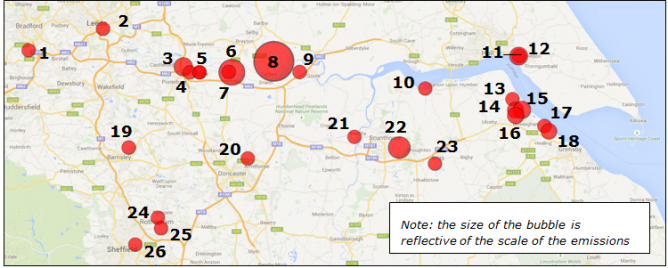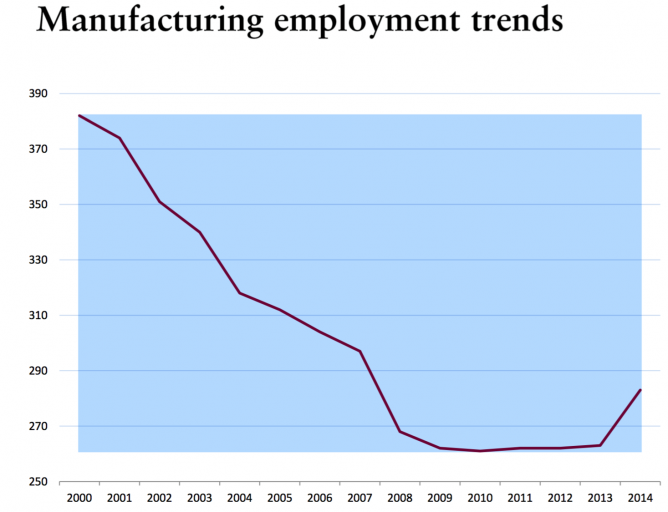Low Carbon Task Force in Yorkshire and Humber
If there was ever a testbed for modern industrial strategy fit for the future, it’s in the Yorkshire and Humber region. This is a region in transition but without a plan.
Our region has probably the highest concentration of the UK’s foundation industries and coal and gas power stations in the UK. This includes major power plants like Drax, as well as steel, cement and chemical works, glass manufacturers, and heavy energy users in brewing and food manufacture. The regional TUC reckons that up to 28,000 people work in these major plants, and three or four times as many in their supply chains.
No UK region has a bigger carbon footprint than this, because of the energy these industries either supply or use. So, no region has a bigger question to answer than: How to protect and develop our foundation industries and deliver the jobs, skills and training fora just transition to a low carbon economy?
The facts
This map shows 26 of the region’s biggest emitters of carbon dioxide and other greenhouse gases. About 28,000 people work directly in these industries, and thousands more in the supply chain and local economy. The TUC study, Strategies for a low carbon industrial future in Yorkshire & The Humber (2015) provides a deep analysis of the region’s manufacturing and energy employment and carbon emissions, and the jobs and industrial plant at risk.

There are more sites than this if we could add the food manufacturers, brewing industries and other major plant.
But this region has lost tens of thousands of manufacturing jobs. The Leeds Local Enterprise Partnership (LEP) said industrial decline has hollowed out the workforce - the ‘missing middle’ - as good paying, skilled industrial jobs disappear while low paid work (and a few high-end financial sector jobs) move in.

Our region has seen the consequences: industrial decline brings poverty, low skills, lack of opportunity, and the resentful sense of communities left behind that is now driving political change. Yorkshire and the Humber voted ‘Leave’ on the back of this ‘left behind’ economy.
Our response
The regional TUC has set up a Low Carbon Task Force to bring together all the key partners in the region to help develop a regional low carbon transition plan: unions, business, Local Enterprise Partnerships and environmental groups.
Our AGM in March 2018 supported this plan with a powerful resolution, committing the TUC ‘to working with all partners to find sustainable solutions that can ensure the continued operation of these essential industries and protect the jobs they provide.’
The resolution carries forward the UK’s international commitments to reduce carbon gas emissions.
In 2014, the Yorkshire & the Humber TUC was chosen as one of seven leading industrial regions in Europe to take part in a special report, Industrial regions and climate change policies towards a just transition. The project was led by the European TUC, which hosted debates on fringes of the UN’s climate conference in Paris in December 2015. The report was one of many influences persuading governments to adopt the principle of a just transition into the opening Preamble of the Paris Agreement.
The Low Carbon Task Force
- Membership: Industries, trade unions, LEPs, environmental campaigns like Sheffield Climate Alliance and Friends of the Earth.
- Aim: engaging all the partners to build a Just Transition strategy and the resources needed to deliver it.
The region can already be proud of a number case studies where employees, unions and employers have got together to deliver a wide range of changes, such as fuel switching, energy efficiency, new industrial process and reskilling. Industries such as chemicals, cement and steel, where production processes chemically generate carbon dioxide, need new investment in carbon capture technologies, where this can be seen to work.
Under present government structures, Local Enterprise Partnerships have an important role to play. They have a key role to play in coordinating businesses, attracting such government funds as are available, and investing in skills and training.
However, the TUC is concerned that the Government’s Industrial Strategy and Clean Growth Strategy each fail to mention the need for a Just Transition. Such an effort has been diverted into Brexit that the Government’s 2050 Industrial Roadmaps for heavy industry, which say that firms can feasibly cut their carbon emission by three-quarters, are not making headway.
So, this year, a key goal is to work towards a new forum that brings unions, employers, local government and the LEPs, Universities and campaigning organisations together to develop a just transition strategy for the region.
- We need to organise from the workplace upwards, to work locally and regionally.
- The closer the consultation between the unions, employees and management the more likely we are to make progress – protecting and growing skilled, good paying, union jobs.
- For the consultation agenda with management, consider including an item on the company’s plans to save energy, cut carbon emissions, and invest in new low carbon processes and technologies.
- We need to look to industry and business support groups like the Local Enterprise Partnerships, because of the likely investment, new processes and low carbon technologies involved.
- Some of the new technologies will only come about through shared solutions - carbon capture and storage technology for heavy industry, heat networks that can share waste heat within industrial clusters.
- Yorkshire & the Humber Regional TUC will offer an environmental training programme and stewards’ briefings. We are participating in the ETUC Just Transition project to learn from trade union and industry experience across Europe and beyond.
The government’s 2050 Industrial Roadmaps indicate the kind of new technologies and process required:
|
Sector |
For maximum cuts in carbon emissions: examples of new technologies needed |
|---|---|
|
Iron & steel |
Carbon capture and storage technology needed; retrofit or rebuild to boost efficiency; onsite renewable energy. |
|
Chemicals |
Biomass to generate heat and as chemical feedstock; carbon capture & storage (CCS); energy efficiency measures; clustering of chemical production to optimise energy use. |
|
Oil Refining |
Carbon capture; refinery refits with best available technology. |
|
Cement |
Carbon capture; fuel switching to biomass or waste; product substitution. |
|
Ceramics |
Decarbonise heat by substituting fossil fuel with electricity or biomass; CCS. |
|
Glass |
Electric melting and biogas; new glass recycling strategies with local government. |
|
Pulp and paper |
Clustering and heat networking; 100% electricity; heat recovery; biomass-based heat and power. |
|
Food and drink |
Biggest energy demands in baking, brewing, meat and sugar manufacture: improve process controls; greater energy efficiency in refrigeration, heating and cooling; low energy lighting systems; onsite renewable energy. |
Source: 2050 Industrial Roadmaps.
Brexit vote explained: poverty, low skills and lack of opportunities, Joseph Rowntree Foundation, 2016. https://www.jrf.org.uk/report/brexit-vote-explained
Stay Updated
Want to hear about our latest news and blogs?
Sign up now to get it straight to your inbox
